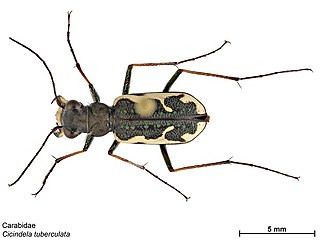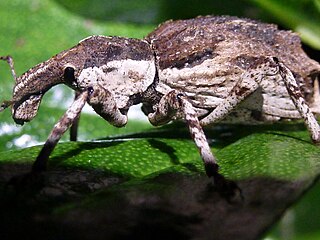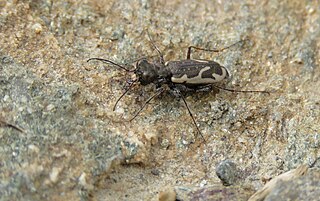
Beetles are insects that form the order Coleoptera, in the superorder Holometabola. Their front pair of wings are hardened into wing-cases, elytra, distinguishing them from most other insects. The Coleoptera, with about 400,000 described species, is the largest of all orders, constituting almost 40% of described insects and 25% of all known animal species; new species are discovered frequently, with estimates suggesting that there are between 0.9 and 2.1 million total species. Found in almost every habitat except the sea and the polar regions, they interact with their ecosystems in several ways: beetles often feed on plants and fungi, break down animal and plant debris, and eat other invertebrates. Some species are serious agricultural pests, such as the Colorado potato beetle, while others such as Coccinellidae eat aphids, scale insects, thrips, and other plant-sucking insects that damage crops. Some others also have unusual characteristics, such as fireflies, which use a light-emitting organ for mating and communication purposes.

Neocicindela tuberculata is a species of tiger beetle in the family Cicindelidae, endemic to New Zealand. Its common names include common tiger beetle, moeone, and papapa, and in its larval stage penny doctor, butcher boy, kapuku, kui, kurikuri, moeone, and muremure. Neocicindela tuberculata was the first carabid beetle described from New Zealand. The species can run as fast as 5 miles per hour and are considered to be the fastest running beetles. Adult species prefer clay banks in summer and are good predators when in comes to insects.

Mecodema oconnori is a large-bodied species of ground beetle that is found mainly on the western regions of the North Island, New Zealand. It is mainly found in native forest habitats, both intact and fragmented, and on the edges of pine plantations. Mecodema oconnori ranges from Otaki, Kapiti Coast to Raglan, but is also found in the Manawatu Gorge and some other eastern localities.

Pericoptus truncatus is a large sand scarab beetle. It is native to New Zealand and is found on beaches throughout New Zealand. Its Māori name is ngungutawa.

Holcaspis is a genus of beetles in the family Carabidae, endemic to New Zealand.

Lanelater mastersii is a species of click beetle belonging to the family Elateridae.

Anagotus stephenensis, commonly known as the ngaio weevil, is a large flightless weevil that is only found on Stephens Island in New Zealand. The ngaio weevil was discovered in 1916 by A.C. O'Connor on Stephens Island. Thomas Broun described it in 1921 as Phaeophanus oconnori after its collector. The weevils were observed at the time to be 'feeding on tall fescue and the leaves of trees'.

Megadromus antarcticus, also known as the “Alexander beetle”, is a member of the Carabidae family and only found in the Canterbury region of New Zealand. Megadromus antarcticus are easily recognized by their iridescent green colouration.

Scolopterus penicillatus, also known as the black spined weevil, is an endemic beetle of New Zealand. The beetle is present throughout New Zealand and can be discovered by beating native flowering plants in the summer months. In appearance it is a shining black colour with a purplish tinge and looks very similar to its close relative Scolopterus tetracanthus. S. penicillatus can be distinguished from S. tetracanthus as the spines on the shoulders of the former are much less pointed. Adult black spined weevils have been collected from Hedychium gardnerianum and caught in the flowers of Helichrysum lanceolatum. The larvae of S. penicillatus are known to develop in the recently dead bark of the various species of Pseudopanax.

Hadramphus spinipennis, commonly called the coxella weevil, is a large, nocturnal, flightless weevil only found on Mangere and Rangatira Islands in the Chatham Islands, New Zealand.

Anisodactylus binotatus is a species of ground beetle native to Europe. It was discovered as being introduced to Canterbury, New Zealand in 1938. Anisodactylus binotatus is a species of Carabidae, also known as the ground beetle family. Although this species of beetle has no official recorded common names, literature from England refers to it as the common shortspur beetle.

Lyperobius huttoni is a New Zealand weevil found in alpine areas of the South Island and at sea level around the Wellington coast. It feeds only on speargrass (Aciphylla). Weevils from the endangered Wellington population have been translocated to predator-free Mana Island.

Lyperobius hudsoni is a flightless weevil found in alpine areas of Central Otago and Otago Lakes in the South Island of New Zealand.

Oemona hirta, the lemon tree borer, also known as the whistling beetle or the singing beetle, is a longhorn beetle endemic to New Zealand. Its larvae are generalist feeders, boring into the wood of a wide variety of trees, native and introduced. When citrus orchards were first established in New Zealand, this beetle started inflicting serious damage, and so gained the name "lemon tree borer". Four species within the genus Oemona have been identified, suggesting that more species could be found. When disturbed by predators or humans, the adult beetle stridulates creating a "rasp" or "squeak" sound by rubbing its thorax and head together against an area of thin ridges. Māori would eat a liquid called "pia manuka", which was produced by manuka trees when its wood was damaged by the larvae. When Captain Cook first arrived in NZ, his naturalists, Banks and Solander, collected a lemon tree borer in their first collection between 1769 and 1771. This oldest collected specimen can be found in the British Museum. A few years after the first collection, the species would be first described by the Danish naturalist Fabricius in 1775.

Anagotus oconnori or Astelia weevil is a large flightless weevil found in New Zealand. It was first collected on Mount Quoin in Wellington from Astelia by Mr A.C. O'Connor after whom this species was named.

Hoherius meinertzhageni, the ribbonwood fungus weevil, is an endemic New Zealand beetle that has been recorded feeding on the ribbonwood species Plagianthus regius and Plagianthus divaricatus and the mountain lacebark, Hoheria glabrata.
Stictomela opulenta, is a species of handsome fungus beetle found in Sri Lanka.
Eutassa fuscicollis is a beetle in the Curculionidae family. It was first described by Thomas Broun in 1909, and is endemic to New Zealand

Prodontria longitarsis is a species of flightless beetle in the family Scarabaeidae. This species was first described by Broun in 1909 as Odontria longitarsis. The holotype specimen was collected by George Hudson during the Sub-Antarctic Islands Scientific Expedition and is held at Te Papa.

Neocicindela dunedensis, also known as the Dunedin tiger beetle, is a small species of tiger beetle in the genus Neocicindela endemic to New Zealand.




















